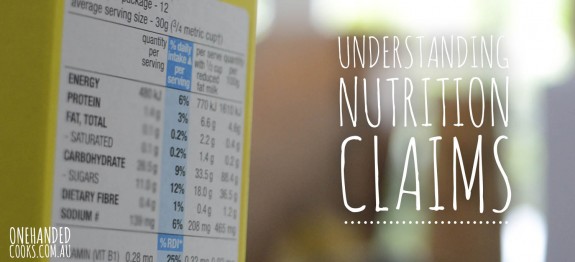Understanding Food Labels Part 2: Nutrition Claims
Understanding Nutrition Claims
Low fat, reduced fat, high fibre, reduced salt, low salt, low sugar…! How many nutrient claims can one product list and how many do you have to understand? Well, there are lots actually and some can be easily misunderstood making you choose a product that is not as healthy as you think! There are criteria that must be met if a product wishes to make a nutrition claim. Here’s a quick run down of the ones we think you should know.
Fat
Low in fat: Less than 3.0g of fat per 100g of food or less than 1.5g of fat per 100ml of liquid food.
Reduced fat: 25% or more less fat and less than 3g less fat per 100g than the regular product.
Low in saturated fat: Less than 1.5g of saturated fat per 100g of food or less than 0.75g per 100ml of liquid food.
*Remember low fat dairy products are unsuitable for children under 2 years of age.
*A large amounts of fat is considered to be more than 20g per 100g.
Sugar
Low in sugar: Less than 5.0g of sugar per 100g of food or less than 2.5g sugar per 100ml of liquid food.
No added sugar: No sugar has been added but the food product may still be high in natural sugars, e.g dried fruit,
*If a baby food has more than 4.0g of added sugar it must have the word “sweetened” on it.
*A large amount of sugar is considered to be more than 30g per 100g.
Sodium (Salt)
Very low in salt: Less than 40 mg sodium per 100g.
Low in salt: Less than 120 mg sodium per 100g.
Reduced salt: Contains 25% less sodium and 90 mg less sodium than the original product however may the product may still be high in salt.
No added salt: No salt has been added to the product but it may still be high in natural salts.
*For babies and young children aim to choose food products with a sodium content of less than 75mg per 100g to help keep their sodium intake low. Note baby rusks will be higher.
*Thankfully you won’t see salt as an ingredient in packaged food for babies under 12 months in Australia and New Zealand as it’s not allowed.
*A food containing between 120-600 mg of sodium per 100g is considered to be moderate in its salt content and more than 600 mg of sodium per 100g is considered to be high.
Fibre
High in fibre/Good source of fibre: Contains 3.0g or more of fibre per serve of food.
Very high in fibre/Excellent source of fibre: Contains 6.0g or more of fibre per serve of food.
Remember to take a look at the nutrition information panel. Some claims can be very misleading! A product may be low in fat but may still be high in salt. And be careful when interpreting the word “Light” or “Lite” when you see it displayed on food packaging – it may mean the product is lower in fat or lower in kilojoules but it may also just mean light in taste, flavour or colour! Foods that claim to be ‘baked not fried’ may not be a healthier choice as they may still contain just as much fat. Check the nutrition information panel to be sure.
This article was featured in our Launch issue of our Magazine. To find out more about our popular magazines or to purchase online see the links below:
Join us on Facebook for other foodie bits and pieces.



























